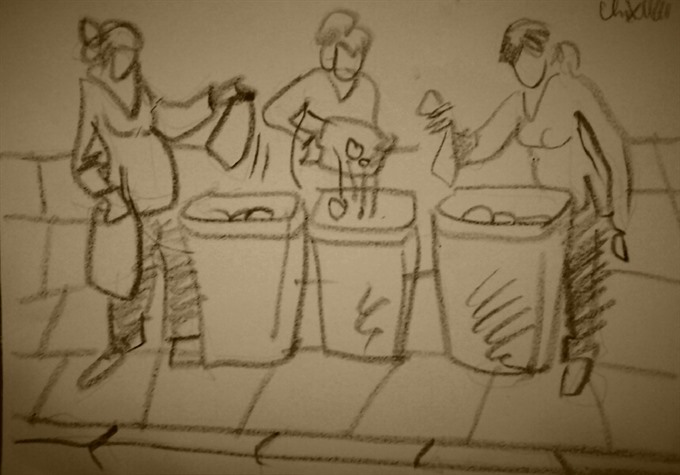 Talk Around Town
Talk Around Town

In a rather sudden and widely applauded move, the HCM City authorities a few days ago issued regulations forcing the city folks to start separating their solid waste at source.
 |
| Illustration by Đàm Minh Chí |
By Chi Lan
In a rather sudden and widely applauded move, HCM City authorities have issued regulations forcing the city’s folk to start separating their solid waste at source.
That means they have to quickly familiarise themselves with a new practice of throwing out garbage. It is no longer a simple but environmentally-neglected job of tossing everything into a nylon bag and waiting for it to be picked up by the collector.
Instead, according to the HCM City People’s Committee, rubbish must be sorted into three kinds of degradable organic waste, dry recyclable and the rest, which then will be put into different bags of distinguishable colours.
Those failing to do so might face a fine of up to VNĐ20 million (US$880) - quite a lot of money compared to only VNĐ7 million levied on littering.
The campaign seemed to be set on the right track, said a resident named Định living in District 9.
He said every household in his neighbourhood received a leaflet from the local ward People’s Committee instructing how to sort waste at home. The guidance was beautifully printed in colour with clear information to help people tell apart different kinds of waste and how to store them in garbage bags, he said.
“It is just a leaflet to encourage the residents to sort their garbage but it is so carefully designed to be so catchy,” Định said.
“Encouraging people to change their old habits might yet to see immediate results. It will take time and patience but it really needs good impression like this in the first place.”
HCM City was under tremendous pressure to handle around 8,300 tonnes of solid waste everyday, making garbage management one of the “most urgent issues” of the southern hub, the municipal Department of Natural Resources and Environment director Nguyễn Toàn Thắng told the online newspaper Vnexpress.
“The goal of the city authorities is not to levy fines to gain money, but to raise the people’s awareness and responsibility in environmental protection,” he said.
HCM City buried about 76 per cent of the total waste it collected, and only managed to recycle some 14.7 per cent of plastic waste.
Waste separation at source is hoped to raise the rate of recycling as there will be more collected waste that is not polluted by other trash, making it possible to process into high quality recycled products.
Meanwhile, the rate of waste to be buried would also go down which would help cut costs and reducing environmental pollution.
While the majority of people supported the regulation, many still questioned if the authorities could actually pull it off given that Việt Nam’s long-known Achilles heel is not in thinking of a good policy but rather implementing it.
Once mentioning waste separation at source, it could not help but to be reminded about the biggest trial, and also failure, of the capital city of Hà Nội more than a decade ago.
A campaign called 3R, which stands for Reduce-Reuse-Recycle, was rolled out in Hà Nội in 2006 to encourage the residents to sort their trash at source.
At first it was a success, with people getting into the habit of separating their waste. Yet soon after funding for the project drained, it was the garbage collectors who refused to separately collect the sorted waste and instead mixed them all up due to a lack of budget.
The residents, hence, gave up the sorting practice too.
That was exactly what worried Đỗ Thị Thùy Trang, an office worker in HCM City’s District 1.
Trang said she wanted to join in, but noticed garbage collection didn’t have different vehicles to collect specific kinds of waste.
“It will be meaningless to sort the trash only to have it all mixed again,” she said.
Waste separation is not only about the awareness of the citizens. It demands more, most of it actually from the authorities themselves.
There is a heap of work for HCM City People’s Committee and relevant authorities to do if they want to steer clear of Hà Nội’s failings.
First, they need to properly organise the routes of sorted waste going from houses to the dump sites and recycling facilities, in which specific waste collection places are set up and the collection time is scheduled and maintained while the collection companies have specialised lorries for different kinds of waste.
They also should prioritise the forcing of waste separation at places that are the easiest to monitor and keep track of, for example, schools, hospitals, offices and factories or modern residential complexes.
The sorting practice can then be expanded to more complicated areas like traditional markets, coach stations and residential areas in deep alleys.
The most important thing is that the authorities can build adequate infrastructure, proper procedures and an effective monitoring system to facilitate its policy and encourage the residents to take part in.
It is undeniably hard and requires a lot of work and determination, but that is the only way that HCM City, or any other locality, can do to make their policy a success instead of relying on repeated calls for the residents’ awareness. - VNS